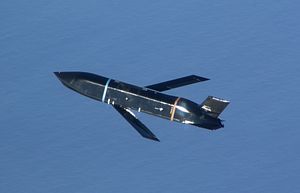The U.S. Defense Security Cooperation Agency (DSCA) announced on Friday that the U.S. Department of State had notified Congress of a possible sale to Australia of as many as 200 AGM-158C Long-Range Anti-Ship Missiles (LRASMs). The value of the sale, if finalized, would be around $990 million, the release said.
In addition to 200 LRASMs, the sale could include “DATM-158C LRASM, Captive Air Training Missiles (CATM-158C LRASM), containers, support and test equipment, publications and technical documentation, personnel training and training equipment, U.S. Government and contractor representatives technical assistance, engineering and logistics support services, and other related elements of logistics support,” DSCA said in its statement.
“This proposed sale will support the foreign policy and national security objectives of the United States. Australia is one of our most important allies in the Western Pacific,” the statement added. “The strategic location of this political and economic power contributes significantly to ensuring peace and economic stability in the region.”
The LRASM was originally developed for the United States Air Force and Navy for use against ship targets. The cruise missile, which was designed for low-observable, low-altitude flight, can deliver a 450 kg blast-fragmentation conventional warhead to ranges in excess of 500 nautical miles. The system is based on the air-launched AGM-158B Joint Air-to-Surface Standoff Missile (JASSM).
LRASM was developed after the U.S. Pacific Fleet identified an operational need for a system capable of holding at risk heavily defended ship targets. Each LRASM unit includes an anti-radiation homing capability and a datalink to provide in-flight updates. The LRASM is designed to operate in environments where long-range intelligence, surveillance, and reconnaissance capabilities might be denied by reducing its reliance on remote ISR platforms.
Australia’s 2016 defense white paper identified a need for Canberra to invest in “improved strike capabilities.” The white paper specifically called for the “acquisition of new deployable land-based anti-ship missiles to support operations to protect deployed forces and vital offshore assets such as oil and natural gas platforms.”
The LRASM could be operated by Royal Australia Air Force (RAAF) Super Hornet fighters. (U.S. Navy F/A-18E/F Super Hornets are capable of launching the LRASM.) Additionally, certain Royal Australian Navy surface combatants, including the Hobart-class air warfare destroyer featuring 48 Mark 41 Vertical Launch System cells, can launch the LRASM.
The RAN’s Hunter-class frigates, which also feature the Mark 41 VLS, will be capable of launching the LRASM as well. Both vessels may also be capable of topside launching the LRASM. The missile is slated to offer RAN surface combatants a direct upgrade path from the older Harpoon anti-ship cruise missile.

































